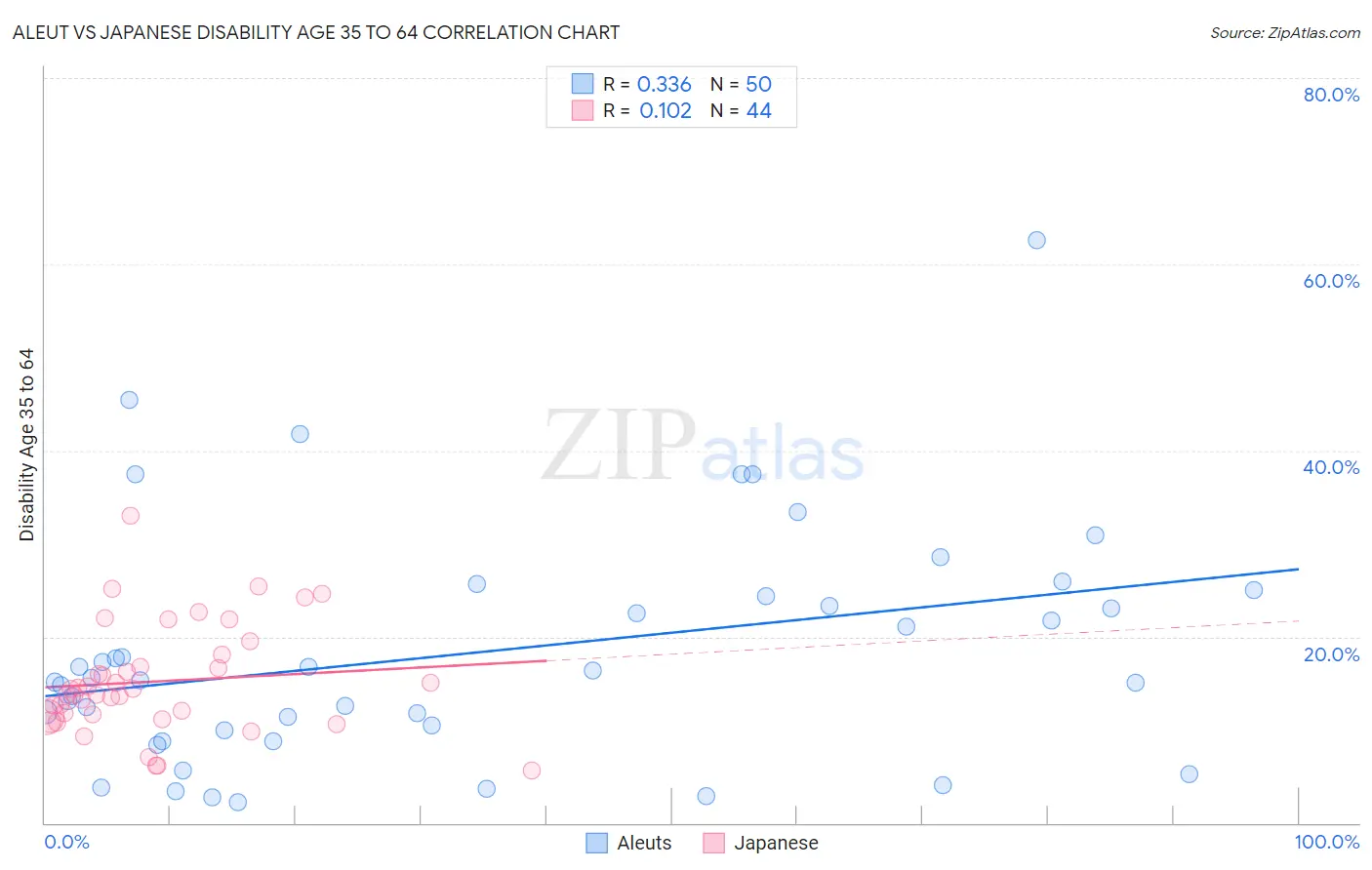Aleut vs Japanese Disability Age 35 to 64
COMPARE
Aleut
Japanese
Disability Age 35 to 64
Disability Age 35 to 64 Comparison
Aleuts
Japanese
13.8%
DISABILITY AGE 35 TO 64
0.0/ 100
METRIC RATING
302nd/ 347
METRIC RANK
12.3%
DISABILITY AGE 35 TO 64
0.8/ 100
METRIC RATING
255th/ 347
METRIC RANK
Aleut vs Japanese Disability Age 35 to 64 Correlation Chart
The statistical analysis conducted on geographies consisting of 61,774,643 people shows a mild positive correlation between the proportion of Aleuts and percentage of population with a disability between the ages 34 and 64 in the United States with a correlation coefficient (R) of 0.336 and weighted average of 13.8%. Similarly, the statistical analysis conducted on geographies consisting of 249,049,051 people shows a poor positive correlation between the proportion of Japanese and percentage of population with a disability between the ages 34 and 64 in the United States with a correlation coefficient (R) of 0.102 and weighted average of 12.3%, a difference of 12.0%.

Disability Age 35 to 64 Correlation Summary
| Measurement | Aleut | Japanese |
| Minimum | 2.2% | 5.7% |
| Maximum | 62.6% | 33.0% |
| Range | 60.4% | 27.4% |
| Mean | 18.3% | 15.2% |
| Median | 15.4% | 14.1% |
| Interquartile 25% (IQ1) | 9.9% | 11.5% |
| Interquartile 75% (IQ3) | 24.4% | 17.4% |
| Interquartile Range (IQR) | 14.5% | 5.9% |
| Standard Deviation (Sample) | 12.6% | 5.8% |
| Standard Deviation (Population) | 12.5% | 5.7% |
Similar Demographics by Disability Age 35 to 64
Demographics Similar to Aleuts by Disability Age 35 to 64
In terms of disability age 35 to 64, the demographic groups most similar to Aleuts are Sioux (13.9%, a difference of 0.18%), Hopi (13.9%, a difference of 0.21%), American (13.9%, a difference of 0.59%), French American Indian (13.7%, a difference of 0.89%), and Delaware (13.7%, a difference of 1.2%).
| Demographics | Rating | Rank | Disability Age 35 to 64 |
| Yakama | 0.0 /100 | #295 | Tragic 13.6% |
| Africans | 0.0 /100 | #296 | Tragic 13.6% |
| Bangladeshis | 0.0 /100 | #297 | Tragic 13.6% |
| Cheyenne | 0.0 /100 | #298 | Tragic 13.6% |
| Spanish Americans | 0.0 /100 | #299 | Tragic 13.7% |
| Delaware | 0.0 /100 | #300 | Tragic 13.7% |
| French American Indians | 0.0 /100 | #301 | Tragic 13.7% |
| Aleuts | 0.0 /100 | #302 | Tragic 13.8% |
| Sioux | 0.0 /100 | #303 | Tragic 13.9% |
| Hopi | 0.0 /100 | #304 | Tragic 13.9% |
| Americans | 0.0 /100 | #305 | Tragic 13.9% |
| Immigrants | Yemen | 0.0 /100 | #306 | Tragic 14.0% |
| Blackfeet | 0.0 /100 | #307 | Tragic 14.1% |
| Inupiat | 0.0 /100 | #308 | Tragic 14.1% |
| Cree | 0.0 /100 | #309 | Tragic 14.1% |
Demographics Similar to Japanese by Disability Age 35 to 64
In terms of disability age 35 to 64, the demographic groups most similar to Japanese are Hawaiian (12.3%, a difference of 0.13%), Scottish (12.4%, a difference of 0.17%), Dutch (12.3%, a difference of 0.25%), Irish (12.3%, a difference of 0.28%), and Mexican (12.4%, a difference of 0.42%).
| Demographics | Rating | Rank | Disability Age 35 to 64 |
| Spaniards | 1.3 /100 | #248 | Tragic 12.3% |
| Hispanics or Latinos | 1.3 /100 | #249 | Tragic 12.3% |
| Immigrants | Burma/Myanmar | 1.2 /100 | #250 | Tragic 12.3% |
| Germans | 1.1 /100 | #251 | Tragic 12.3% |
| Irish | 1.0 /100 | #252 | Tragic 12.3% |
| Dutch | 1.0 /100 | #253 | Tragic 12.3% |
| Hawaiians | 0.9 /100 | #254 | Tragic 12.3% |
| Japanese | 0.8 /100 | #255 | Tragic 12.3% |
| Scottish | 0.8 /100 | #256 | Tragic 12.4% |
| Mexicans | 0.7 /100 | #257 | Tragic 12.4% |
| Welsh | 0.6 /100 | #258 | Tragic 12.4% |
| English | 0.6 /100 | #259 | Tragic 12.4% |
| German Russians | 0.5 /100 | #260 | Tragic 12.5% |
| Malaysians | 0.5 /100 | #261 | Tragic 12.5% |
| Senegalese | 0.5 /100 | #262 | Tragic 12.5% |